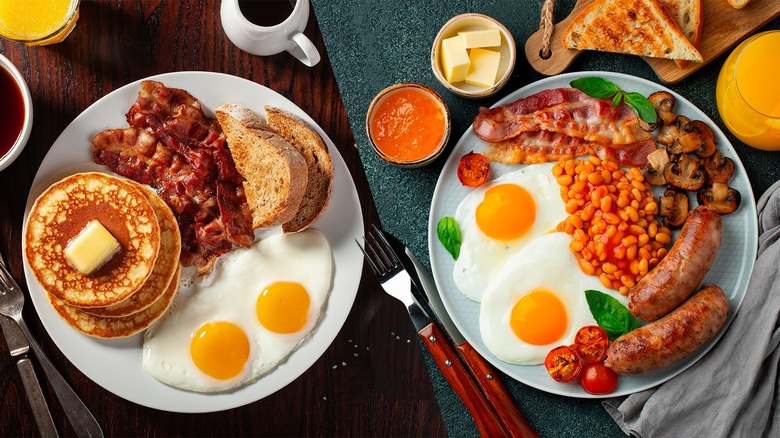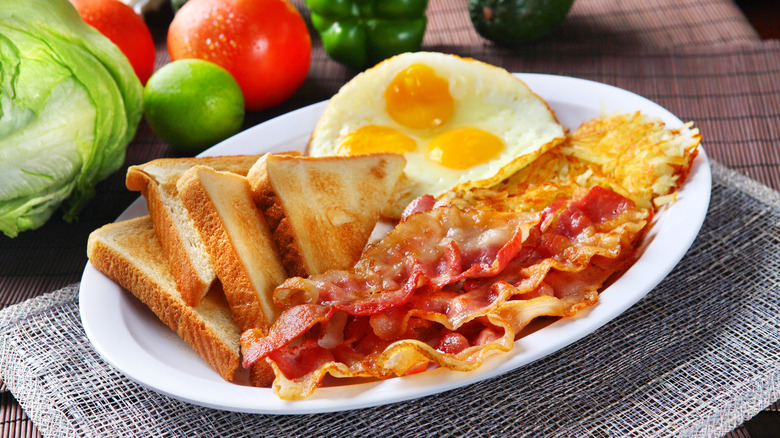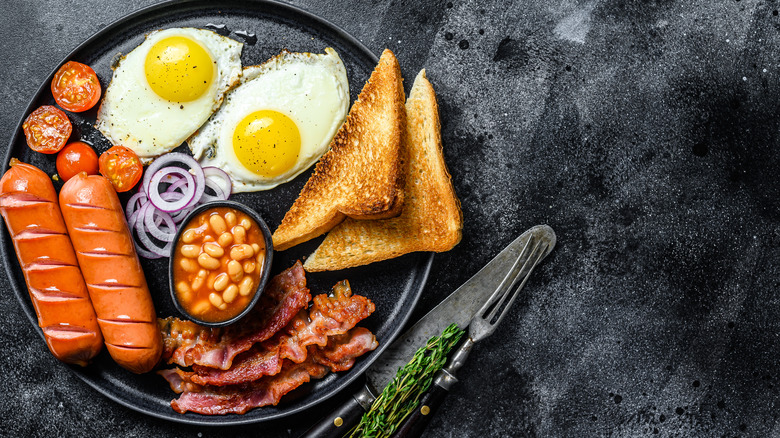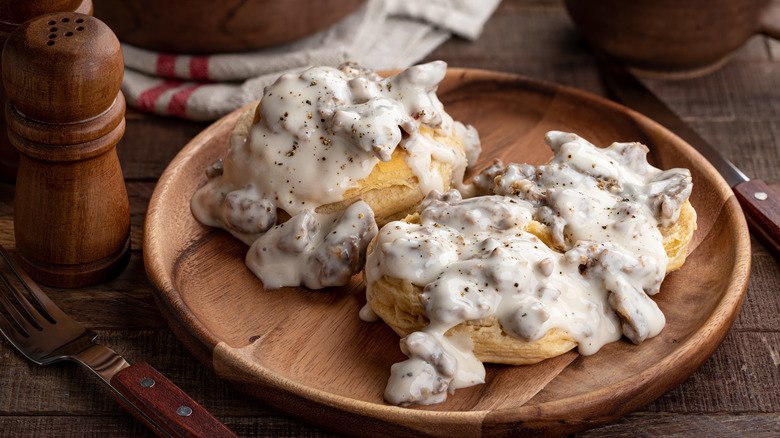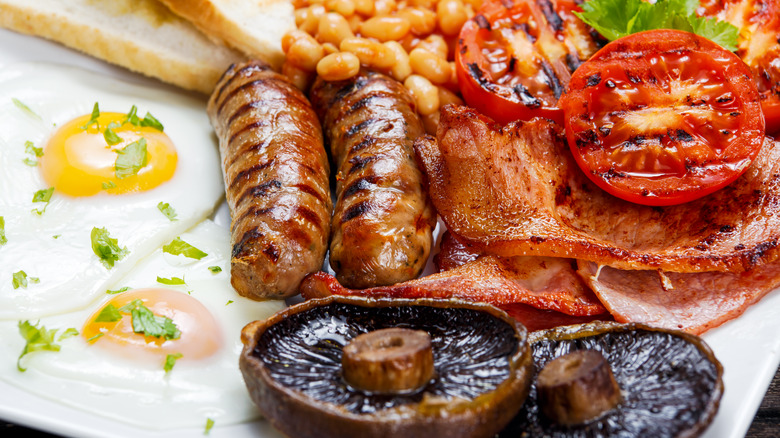American Vs Full English Breakfast: What's The Difference?
Breakfast is a beloved meal — what better way to start the day than with some tasty food? Morning preferences are abundant, explaining the dozens of breakfast recipes in existence. International cuisines each have their own early meal traditions, too, from Malaysia's hearty rice-based Nasi Lemak to Mexico's leftover reused chilaquiles.
The U.S. and the U.K. are also blessed with great breakfast culinary traditions. Although foods across the pond may seem similar, there's actually quite a bit of distinction between an American and full English breakfast — enough to spark debate. The British consumption of beans for breakfast incites divisive opinions. Conversely, an American plate often comes with a sweet item like waffles or pancakes, a confusing accompaniment to a piece of bacon or eggs to some.
Then, there's the tradition behind each dish to consider. An English full breakfast is a venerable, centuries-old dish, while the American breakfast is a more open-ended meal, influenced by 20th-century marketing. In the U.S., one can enter a diner and spontaneously patch together foods — a move that's a drastic contrast to the well-thought-out combinations on an English plate. Such intricacies reveal a fascinating contrast in culinary attitudes.
What is an American breakfast?
From the iconic American diner combo to the growing appeal of fast-food chain breakfast menus, morning fare is a prominent part of U.S. cuisine. Most Americans eat their first meal at home, oftentimes a simple bite like a bagel or smoothie. And there's cereal, too — a food popularized by 20th-century marketing that's still a beloved domestic favorite. However, especially on a weekend or when eaten out, American breakfast is a more filling experience.
The meal will almost certainly include eggs — the most popular American breakfast food — followed by toast, which is the second dependable option. If meat's on the plate, it's going to be cured, taking on the form of bacon or breakfast sausage. Potatoes are a popular complement, often made as a hash, but always ready for an assortment of breakfast potato upgrades.
Whether on the same plate or as a side, Americans love a sweet item for breakfast. It's usually in the form of pancakes, perhaps a waffle, or a cinnamon roll. To wash it down, it's classically orange juice and coffee. Add it all up together, and an American breakfast plate is a malleable dish. When ordering at a restaurant, patrons mix and match items to their taste, and note their preferred way to cook eggs.
What is a full English breakfast?
Full English breakfast is a national dish with an estimated origin all the way back to the 15th century. Emerging from upper-class countryside estates, the meal purposefully comprised impressive spreads made to showcase culinary wealth. By the 20th century, full English breakfast adapted to an everyman's morning routine, enjoyed by many in casual Greasy Spoon eateries.
The precise composition of a fry-up — its alternate name — shifts regionally, but it does have several defining elements. Firstly, and perhaps most importantly, there's the meat. It's typically a pairing of sausage and back bacon, although American-style bacon is utilized, too. Broiled or fried tomatoes, which are sliced in half, bring a touch of color and acidity. Bread is another mandatory addition, typically in fried or toasted form. Being breakfast, eggs are part of the meal, usually made over easy. And baked beans tie the whole plate together, mixing everything into sauced varied bites.
The dish is enjoyed all around the U.K., so each country carries its own regional variation. Specifically, the full English breakfast often comes with black or white pudding, which is not the same thing as American pudding, as well as bubble and squeak, a leftover makeover comprised of potatoes, cabbage, and other roasted vegetables. The meal's served with a mug of tea or coffee, alone or with a group of friends in a casual setting.
American breakfast doesn't have a definite ingredient combination
Eating breakfast in America can take on many forms, and unlike the English counterpart, the name isn't tied to a specific assortment of ingredients. Walk into a hotel, and you'll get a continental breakfast — which is a nod to lighter, mainland European-style eating. It'll be an assortment of pastries, perhaps a yogurt, all washed down with a cup of coffee.
Such an interpretation of the American breakfast is lighter, more modern, and less classic. More traditional are the large diner plates, filled with eggs, meats, potatoes, and sweets, all heaped to provide a filling start to the day. In addition to all the varying combination possibilities, there's also the dish's regional nature.
In the South, there's the beloved pairing of biscuits and sausage gravy, which often shows up on a breakfast plate. Head to Texas — especially Austin — and you'll find migas, made from scrambled eggs combined with fried tortilla strips. Often, they'll be served alongside tortillas for do-it-yourself migas breakfast taco, with chorizo and a side of beans.
Meanwhile, in the Midwest, it's all about hassle-free breakfast casseroles. These dishes — which can be both sweet and savory — pack in different flavorful components, all tied together with eggs. So, even the presence of multiple foods on one plate isn't a necessity for an American breakfast.
Full English breakfast comes served with a respected regional flair
Similarly to American breakfast, the English version absorbs many different foods. From pancakes to pikelets or crumpets, a full pork chop, or even herring, the dish opens to many pairings. However, that's not to say each addition comes casual. Instead, there's a respect for tradition, with contentious opinions on what belongs on a breakfast plate.
Specifically, hash browns spark debate, their more newfound breakfast addendum offputting to some. In fact, potatoes in any form other than bubble and squeak are often seen as a deviation from the classic. The same disdain applies to other vegetables — a picture of peas on a full English breakfast sparked internet outrage. Some view tomatoes, mushrooms, and beans as optional components, cementing the meat and bread as the dish's cornerstone.
It's in the variance of this carb and protein duo that English breakfast gains its regional nature. The bread can be everything from Staffordshire-style oatcakes to Irish brown soda bread, or butteries, a lard-based roll. The meats may include many different sausages, corned hash, or different types of smoked fish in coastal areas. However, what's absent is the do-it-yourself American style of assembly — not everything is welcome on an English breakfast plate. And it certainly can't be thrown together spontaneously like the American counterpart.
